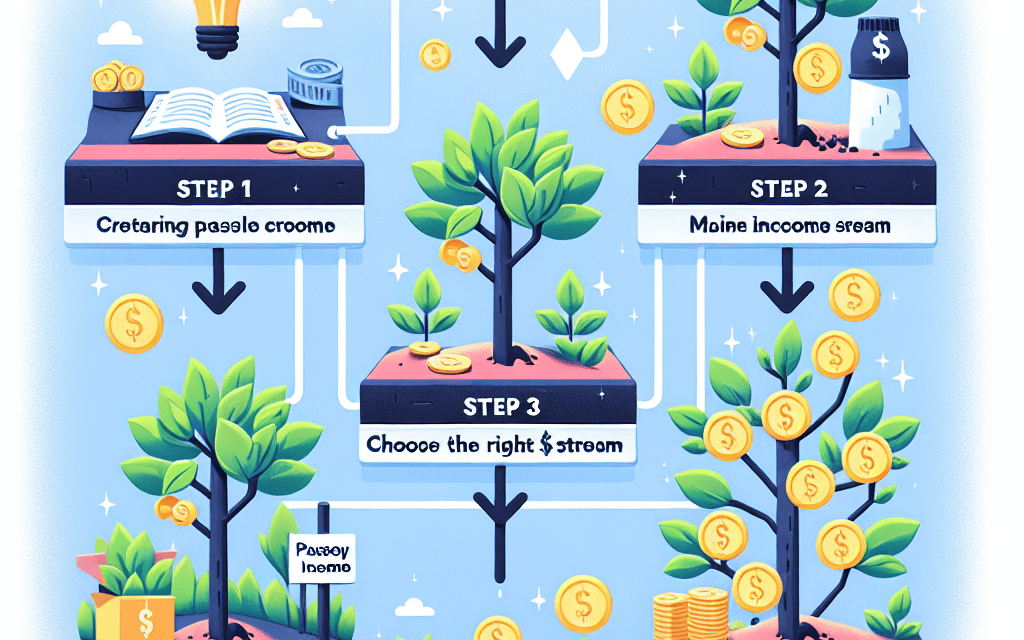“Unlock Financial Freedom: Achieve $4,600 Monthly Passive Income in Just 4 Steps!”
Introduction
Creating a substantial passive income stream is a goal for many seeking financial independence and security. Achieving a $4,600 monthly passive income in less than a year may seem ambitious, but with strategic planning and disciplined execution, it is attainable. This guide outlines four essential steps to help you reach this financial milestone. By focusing on smart investments, leveraging technology, and optimizing your resources, you can build a sustainable income stream that requires minimal ongoing effort. Whether you’re looking to supplement your current income or achieve complete financial freedom, these steps provide a clear roadmap to help you realize your passive income goals efficiently and effectively.
Understanding Passive Income: The Basics
Understanding passive income is crucial for anyone looking to achieve financial independence and security. Passive income refers to earnings derived from ventures in which an individual is not actively involved on a daily basis. This type of income can provide financial stability and freedom, allowing individuals to focus on other pursuits or simply enjoy more leisure time. To create a $4,600 monthly passive income in less than a year, it is essential to grasp the fundamental principles of passive income and implement a strategic plan.
First and foremost, it is important to recognize the various sources of passive income. These can include rental properties, dividend stocks, peer-to-peer lending, and digital products, among others. Each source has its own set of advantages and challenges, and understanding these can help in selecting the most suitable options. For instance, rental properties can offer a steady stream of income, but they require an initial investment and ongoing management. On the other hand, dividend stocks can provide regular payouts with less hands-on involvement, though they are subject to market fluctuations.
Once the potential sources of passive income are identified, the next step is to assess one’s financial situation. This involves evaluating current assets, liabilities, and cash flow to determine how much can be invested initially. It is crucial to set realistic financial goals and timelines, as this will guide the investment strategy. For example, if the goal is to generate $4,600 per month, one must calculate the required investment and expected returns from chosen passive income sources. This financial assessment will also help in identifying any gaps that need to be addressed, such as reducing debt or increasing savings.
With a clear understanding of the financial landscape, the third step is to develop a diversified investment portfolio. Diversification is key to mitigating risks and ensuring a stable income stream. By spreading investments across different asset classes, such as real estate, stocks, and bonds, one can protect against market volatility and enhance the potential for returns. It is advisable to consult with financial advisors or conduct thorough research to make informed decisions about where to allocate resources. Additionally, staying informed about market trends and economic indicators can help in adjusting the portfolio as needed.
Finally, the fourth step involves monitoring and adjusting the strategy as necessary. Passive income generation is not a set-it-and-forget-it endeavor; it requires regular review and adaptation. This means keeping track of income streams, evaluating their performance, and making changes to optimize returns. For instance, if a particular investment is underperforming, it may be wise to reallocate funds to more promising opportunities. Moreover, as financial goals evolve, the strategy should be adjusted to align with new objectives.
In conclusion, creating a $4,600 monthly passive income in less than a year is an ambitious yet achievable goal with the right approach. By understanding the basics of passive income, assessing one’s financial situation, diversifying investments, and continuously monitoring progress, individuals can build a sustainable income stream. This journey requires diligence, patience, and a willingness to adapt, but the rewards of financial independence and security make it a worthwhile pursuit.
Step 1: Identifying Profitable Passive Income Streams
Creating a substantial passive income stream is an appealing goal for many, offering financial freedom and the ability to focus on personal interests without the constant pressure of active work. The first step in this journey is identifying profitable passive income streams that align with your skills, interests, and financial goals. This foundational step is crucial, as it sets the stage for the subsequent actions that will lead to a monthly passive income of $4,600 in less than a year.
To begin with, it is essential to understand what constitutes a passive income stream. Unlike active income, which requires continuous effort and time, passive income is generated with minimal ongoing effort after the initial setup. Common examples include rental income, dividends from investments, royalties from creative works, and earnings from online businesses. Each of these options has its own set of advantages and challenges, and selecting the right one depends on various factors such as your initial capital, risk tolerance, and expertise.
One of the most popular passive income streams is real estate investment. By purchasing properties and renting them out, you can generate a steady flow of income. However, this requires a significant upfront investment and a thorough understanding of the real estate market. Alternatively, investing in Real Estate Investment Trusts (REITs) can offer similar benefits without the need to manage physical properties. REITs allow you to invest in real estate portfolios and earn dividends, providing a more hands-off approach to real estate investment.
Another viable option is dividend investing, which involves purchasing stocks that pay regular dividends. This method requires a keen understanding of the stock market and the ability to identify companies with a strong track record of dividend payments. By reinvesting dividends and strategically growing your portfolio, you can create a reliable income stream. It is important to diversify your investments to mitigate risks and ensure a stable income.
For those with a creative flair, generating royalties from intellectual property can be a lucrative passive income stream. This could involve writing a book, composing music, or creating digital art. Once the initial work is completed and published, it can continue to generate income over time. The key to success in this area is producing high-quality content that resonates with a broad audience, thereby maximizing sales and royalties.
In addition to these traditional methods, the digital age has opened up new avenues for passive income. Creating an online course or starting a blog can be effective ways to share your expertise and generate income through advertising, affiliate marketing, or subscription models. These options require an initial investment of time and effort to create valuable content, but once established, they can provide a consistent income stream.
In conclusion, identifying the right passive income stream is a critical first step in achieving your financial goals. By carefully evaluating your options and aligning them with your personal circumstances, you can lay a solid foundation for building a $4,600 monthly passive income. As you move forward, it is important to remain adaptable and open to new opportunities, ensuring that your passive income strategy evolves with changing market conditions and personal aspirations.
Step 2: Initial Investment and Budgeting Strategies
In the pursuit of creating a $4,600 monthly passive income within a year, the second step involves making an initial investment and implementing effective budgeting strategies. This phase is crucial as it lays the financial groundwork necessary for generating sustainable passive income streams. To begin with, it is essential to assess your current financial situation. This involves taking a comprehensive look at your income, expenses, savings, and any existing investments. By understanding your financial standing, you can determine how much capital you can allocate towards your passive income ventures without jeopardizing your financial stability.
Once you have a clear picture of your finances, the next step is to identify potential investment opportunities that align with your financial goals and risk tolerance. Diversification is key in this regard, as it helps mitigate risks and enhances the potential for returns. Consider a mix of investment vehicles such as stocks, real estate, peer-to-peer lending, or dividend-paying assets. Each of these options has its own risk-reward profile, and understanding these nuances will enable you to make informed decisions.
Simultaneously, it is imperative to establish a realistic budget that accommodates your investment plans. Budgeting is not merely about cutting expenses but rather about optimizing your spending to maximize savings and investment potential. Begin by categorizing your expenses into essentials and non-essentials. Essentials include housing, utilities, groceries, and healthcare, while non-essentials cover discretionary spending such as dining out, entertainment, and luxury purchases. By prioritizing essentials and minimizing non-essential expenditures, you can free up additional funds for investment purposes.
Moreover, adopting a disciplined approach to saving is vital. Consider implementing the 50/30/20 rule, where 50% of your income is allocated to necessities, 30% to discretionary spending, and 20% to savings and investments. This framework provides a balanced approach to managing finances while ensuring that a significant portion is directed towards building your passive income portfolio. Additionally, automating your savings can be an effective strategy to ensure consistency and prevent the temptation to spend.
Furthermore, it is beneficial to explore ways to increase your initial investment capital. This could involve taking on a side hustle, selling unused items, or leveraging skills to generate additional income. The more capital you can invest initially, the greater the potential for generating substantial passive income within the desired timeframe. However, it is crucial to remain cautious and avoid over-leveraging or taking on excessive debt, as this could undermine your financial objectives.
In parallel, continuous education and staying informed about market trends and investment strategies are indispensable. Engaging with financial literature, attending workshops, or consulting with financial advisors can provide valuable insights and enhance your investment acumen. This knowledge will empower you to make strategic decisions and adapt to changing market conditions, thereby optimizing your passive income potential.
In conclusion, the initial investment and budgeting strategies form the cornerstone of building a $4,600 monthly passive income within a year. By thoroughly assessing your financial situation, diversifying investments, implementing a disciplined budgeting approach, and continuously educating yourself, you can create a robust financial foundation. This foundation will not only support your passive income goals but also contribute to long-term financial security and independence.
Step 3: Building and Scaling Your Passive Income Sources

Building and scaling your passive income sources is a crucial step in achieving a $4,600 monthly passive income in less than a year. This phase requires strategic planning, consistent effort, and a keen understanding of the various avenues available for generating passive income. By focusing on diversification, automation, and reinvestment, you can effectively scale your income streams to reach your financial goals.
To begin with, diversification is essential in building a robust passive income portfolio. Relying on a single source of income can be risky, as market fluctuations or unforeseen circumstances may impact its profitability. Therefore, it is advisable to explore multiple avenues such as real estate investments, dividend stocks, peer-to-peer lending, and digital products. Each of these options offers unique benefits and risks, and by spreading your investments across different sectors, you can mitigate potential losses while maximizing returns.
Once you have established a diversified portfolio, the next step is to automate your income streams. Automation not only saves time but also ensures that your income sources continue to generate revenue with minimal intervention. For instance, if you have invested in dividend stocks, setting up a dividend reinvestment plan (DRIP) can automatically reinvest your earnings into additional shares, thereby compounding your returns over time. Similarly, if you have created digital products such as e-books or online courses, utilizing platforms that handle sales, distribution, and customer service can streamline the process and allow you to focus on scaling your offerings.
In addition to automation, reinvestment plays a pivotal role in scaling your passive income. By reinvesting a portion of your earnings back into your income sources, you can accelerate growth and increase your monthly returns. For example, if you own rental properties, using rental income to purchase additional properties can expand your real estate portfolio and boost your passive income. Likewise, reinvesting profits from a successful online business into marketing or product development can enhance its reach and profitability.
Moreover, continuous learning and adaptation are vital in the ever-evolving landscape of passive income generation. Staying informed about market trends, emerging technologies, and new investment opportunities can provide valuable insights and help you make informed decisions. Engaging with online communities, attending workshops, and reading industry publications are effective ways to stay updated and refine your strategies.
Furthermore, it is important to regularly assess the performance of your income sources and make necessary adjustments. This involves analyzing key metrics such as return on investment (ROI), cash flow, and growth potential. By identifying underperforming assets and reallocating resources to more promising opportunities, you can optimize your portfolio and enhance its overall performance.
In conclusion, building and scaling your passive income sources is a dynamic process that requires careful planning, strategic diversification, and ongoing management. By automating processes, reinvesting earnings, and staying informed about market developments, you can effectively grow your income streams and achieve a $4,600 monthly passive income in less than a year. As you progress through this journey, remember that patience and persistence are key, and with the right approach, financial independence is within reach.
Step 4: Monitoring and Optimizing Your Income Streams
In the pursuit of creating a $4,600 monthly passive income in less than a year, the final and crucial step involves monitoring and optimizing your income streams. This step is essential to ensure that your efforts yield the desired financial results and that your passive income sources remain sustainable and efficient over time. By diligently overseeing your investments and making necessary adjustments, you can maximize your returns and secure a stable financial future.
To begin with, it is important to establish a systematic approach to monitoring your income streams. This involves setting up a schedule to regularly review the performance of each investment. Whether your passive income sources include rental properties, dividend stocks, or online businesses, keeping track of their performance is vital. By doing so, you can identify any underperforming assets and take corrective actions promptly. Utilizing financial management tools and software can greatly assist in this process, providing you with real-time data and analytics to make informed decisions.
Moreover, diversification plays a key role in optimizing your income streams. By spreading your investments across various asset classes, you can mitigate risks and enhance the stability of your passive income. For instance, if you have invested heavily in real estate, consider diversifying into stocks or peer-to-peer lending platforms. This not only reduces the impact of market volatility on your overall income but also opens up new avenues for growth. Regularly reassessing your portfolio and reallocating resources as needed can help maintain a balanced and resilient income stream.
In addition to diversification, staying informed about market trends and economic conditions is crucial for optimizing your passive income. By keeping abreast of changes in interest rates, inflation, and industry developments, you can make strategic adjustments to your investments. For example, if interest rates are expected to rise, it might be prudent to lock in fixed-rate investments or explore opportunities in sectors that benefit from such changes. Continuous learning and staying updated with financial news can empower you to make proactive decisions that enhance your income potential.
Furthermore, leveraging technology can significantly aid in the optimization process. Automation tools can streamline various aspects of managing your income streams, from tracking expenses to reinvesting dividends. By automating routine tasks, you free up time to focus on strategic planning and exploring new investment opportunities. Additionally, technology can provide valuable insights through data analysis, helping you identify patterns and trends that may not be immediately apparent.
Lastly, it is essential to maintain a long-term perspective when optimizing your passive income streams. While short-term gains can be enticing, prioritizing sustainable growth ensures that your income remains consistent over time. This involves reinvesting a portion of your earnings back into your income streams to fuel further growth. Whether it is upgrading a rental property, purchasing additional shares, or expanding an online business, reinvestment is a powerful tool for compounding your returns.
In conclusion, monitoring and optimizing your income streams is a dynamic and ongoing process that requires diligence, adaptability, and strategic thinking. By establishing a robust monitoring system, diversifying your investments, staying informed about market trends, leveraging technology, and maintaining a long-term perspective, you can effectively enhance your passive income and achieve your financial goals. Through these efforts, the journey to creating a $4,600 monthly passive income becomes not only attainable but also sustainable, paving the way for financial independence and security.
Overcoming Challenges in Building Passive Income
Building a substantial passive income stream, such as $4,600 monthly, within a year is an ambitious yet achievable goal. However, the journey is not without its challenges. Understanding and overcoming these obstacles is crucial for success. The first challenge many face is the initial capital investment. Passive income often requires upfront financial resources, whether for purchasing real estate, investing in stocks, or starting an online business. To address this, individuals should focus on strategic savings and budgeting. By cutting unnecessary expenses and reallocating funds towards investment opportunities, one can gradually accumulate the necessary capital. Additionally, exploring alternative funding options, such as partnerships or small business loans, can provide the financial boost needed to get started.
Another significant challenge is the lack of knowledge and expertise in the chosen passive income avenue. Whether it’s real estate, dividend investing, or digital products, each requires a specific skill set and understanding. To overcome this, aspiring passive income earners should invest time in education and research. This can be achieved through online courses, books, or mentorship from experienced individuals in the field. By building a solid foundation of knowledge, one can make informed decisions and avoid costly mistakes. Furthermore, staying updated with industry trends and market changes is essential to adapt strategies and maintain a competitive edge.
Time management is also a critical hurdle in building passive income. Many individuals juggle full-time jobs, family responsibilities, and other commitments, leaving little time to focus on developing additional income streams. To tackle this, effective time management techniques must be employed. Prioritizing tasks, setting clear goals, and creating a structured schedule can help maximize productivity. Additionally, leveraging technology and automation tools can streamline processes and free up valuable time. For instance, using property management software for real estate investments or automated trading platforms for stock investments can significantly reduce the time required for active involvement.
Moreover, the fear of failure and risk aversion can hinder progress in building passive income. The uncertainty of returns and potential financial losses can be daunting. To mitigate these fears, it is essential to conduct thorough risk assessments and develop a diversified portfolio. Diversification spreads risk across various investments, reducing the impact of any single failure. Moreover, setting realistic expectations and understanding that passive income growth may be gradual can alleviate anxiety. Embracing a mindset of resilience and learning from setbacks is crucial for long-term success.
Finally, maintaining motivation and perseverance throughout the journey is vital. Building a $4,600 monthly passive income is not an overnight achievement; it requires consistent effort and dedication. Setting short-term milestones and celebrating small victories can keep motivation levels high. Additionally, surrounding oneself with a supportive network of like-minded individuals can provide encouragement and accountability. Engaging in forums, attending networking events, or joining investment groups can foster a sense of community and shared learning.
In conclusion, while the path to creating a substantial passive income stream is fraught with challenges, they are not insurmountable. By addressing the initial capital requirements, acquiring the necessary knowledge, managing time effectively, mitigating risks, and maintaining motivation, individuals can overcome these obstacles. With determination and strategic planning, the goal of achieving a $4,600 monthly passive income within a year can become a reality.
Success Stories: Real-Life Examples of Achieving $4,600 Monthly Passive Income
Achieving a monthly passive income of $4,600 in less than a year may seem like a daunting task, yet real-life success stories demonstrate that it is indeed possible with strategic planning and disciplined execution. By examining these stories, we can identify four key steps that have consistently led individuals to reach this financial milestone. These steps include identifying a viable income stream, investing wisely, leveraging technology, and maintaining a growth mindset.
To begin with, identifying a viable income stream is crucial. Many successful individuals have turned to real estate as a reliable source of passive income. For instance, one couple managed to acquire and rent out several properties within a year, generating substantial monthly returns. They started by purchasing a duplex, living in one unit while renting out the other. This initial investment not only covered their mortgage but also provided additional income. Over time, they reinvested their profits into more properties, gradually building a portfolio that yielded significant passive income. This approach highlights the importance of selecting an income stream that aligns with one’s financial goals and risk tolerance.
In addition to real estate, dividend investing has emerged as another popular strategy. By carefully selecting a diversified portfolio of dividend-paying stocks, individuals can create a steady stream of income. One success story involves an individual who, after extensive research, invested in a mix of high-yield and growth-oriented stocks. By reinvesting dividends and taking advantage of compounding, they were able to achieve their income target within a year. This example underscores the importance of thorough research and strategic investment choices in building passive income.
Moreover, leveraging technology has proven to be a game-changer for many aspiring to achieve financial independence. The rise of digital platforms has opened up new avenues for generating passive income. For instance, some individuals have successfully created and monetized online courses or digital products. By utilizing platforms like Udemy or Teachable, they reached a global audience, generating income with minimal ongoing effort. Similarly, others have tapped into affiliate marketing, earning commissions by promoting products through blogs or social media channels. These examples illustrate how technology can be harnessed to create scalable income streams.
Finally, maintaining a growth mindset is essential for success. Real-life stories often reveal that individuals who achieve significant passive income are those who continuously seek opportunities for learning and improvement. They are not deterred by setbacks but view them as learning experiences. For example, one entrepreneur initially faced challenges with an e-commerce business but persevered by adapting their strategy and learning from industry experts. This resilience ultimately led to a thriving business that contributed significantly to their passive income. Embracing a growth mindset allows individuals to remain adaptable and open to new possibilities, which is crucial in the ever-evolving landscape of passive income opportunities.
In conclusion, the journey to achieving a $4,600 monthly passive income in less than a year is marked by strategic decision-making and a proactive approach. By identifying viable income streams, investing wisely, leveraging technology, and maintaining a growth mindset, individuals can emulate the success stories of those who have reached this financial milestone. These real-life examples serve as a testament to the potential of passive income strategies and inspire others to embark on their own path to financial independence.
Q&A
1. **Question:** What is the first step to creating a $4,600 monthly passive income in less than a year?
– **Answer:** Identify and select a profitable niche or investment opportunity that aligns with your skills and interests.
2. **Question:** What is the second step in this process?
– **Answer:** Develop or acquire assets that generate passive income, such as rental properties, dividend stocks, or digital products.
3. **Question:** What is the third step to achieve this goal?
– **Answer:** Implement a strategy to scale your income streams, such as reinvesting profits or expanding your portfolio.
4. **Question:** What is the fourth and final step in creating this passive income?
– **Answer:** Continuously monitor and optimize your income streams to ensure they remain profitable and sustainable.
5. **Question:** How important is diversification in building passive income?
– **Answer:** Diversification is crucial as it reduces risk and increases the stability of your income by spreading it across multiple sources.
6. **Question:** What role does reinvestment play in achieving a $4,600 monthly passive income?
– **Answer:** Reinvestment helps grow your income streams faster by using profits to acquire more assets or improve existing ones.
7. **Question:** Can passive income be achieved without initial capital?
– **Answer:** While challenging, it is possible through methods like creating digital products or leveraging skills for royalties, but having initial capital can significantly accelerate the process.
Conclusion
Creating a $4,600 monthly passive income in less than a year is an ambitious goal that requires strategic planning and disciplined execution. The four steps to achieve this typically involve identifying and investing in high-yield opportunities, such as real estate, dividend stocks, or online businesses, that can generate consistent returns. It also requires reinvesting earnings to compound growth, optimizing expenses to maximize savings, and continuously educating oneself to adapt to market changes. While challenging, with dedication and the right approach, it is possible to build a substantial passive income stream within a year.





